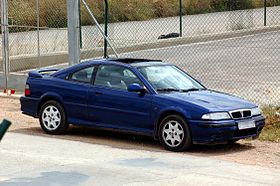Rover 200 Coupé
| Rover 200 Coupé Rover Coupé |
|
|---|---|
 |
|
| Overview | |
| Manufacturer | Rover |
| Production | 1992–1998 |
| Assembly | Longbridge, United Kingdom |
| Body and chassis | |
| Class | Sports car (S) |
| Body style | 2-door coupé |
| Layout | FF layout |
| Related |
Honda Concerto Rover 200 |
| Dimensions | |
| Wheelbase | 2,550 mm (100.4 in) |
| Length | 4,270 mm (168.1 in) |
| Width | 1,680 mm (66.1 in) |
| Height | 1,370 mm (53.9 in) |
The Rover 200 Coupé is a 2-door coupé that was produced by Rover and based on the Rover 200 Mark II, with most of the body panels and the bumpers unique in the range. The car was launched on 6 October 1992, at the Paris Motor Show. It was given the project code name 'Tomcat' when in development.
When introduced, the range flagship - the 220 Turbo Coupé - was the most powerful and fastest production Rover model ever built.
The range was revised in 1996, with new engines, and was renamed Rover Coupé. Production ceased in 1998.
The Rover 200 Coupé was equipped with a specially shaped split glass roof system with a central T-Bar. The twin panels could be tilted or detached independently, and the bar itself could also be removed and stored in the boot in a special protective cover. The glass was an advanced, semi-reflective material, coated with titanium. Transmission of solar heat was restricted to only six per cent, eliminating the need for a sun blind.
The lines of the 200 Coupé resulted from a completely new monoside and front and rear roof panels, new front and rear bumpers and a deep front spoiler extension with large intake grille.
The interior was designed to accommodate four people, with rear seats individually styled. With the application of burr walnut veneer and quality fabrics, the interior was in the Rover traditions of elegance and refinement. Optional leather trim was also available. The Rover 200 Coupé featured infra-red remote central door locking as standard. It also saw the application of ultrasonic alarm system developed originally for the Rover 800 range, giving both perimetric and volumetric protection.
A specially developed version of the established 'Torsen' torque-sensing traction control system - previously only applied to four-wheel-drive and some rear-wheel-drive vehicles (Maserati Biturbo) - was developed to help optimise handling. It was standard on the 220 Turbo Coupé, and optional for the first year of production on the naturally aspirated 220 version. Critics at the time reported that the handling was marred by the power being rather clumsily transmitted through the front wheels. As a result, the handling dynamics fell short of its rivals.
At launch, three engine types gave the Coupé a broad appeal: a Honda D-Series 1.6 litre engine 111 PS (82 kW; 109 bhp), and two Rover 2.0 T-Series engines; a naturally aspirated version producing 136 PS (100 kW; 134 bhp) and a turbo version 200 PS (147 kW; 197 bhp). All versions had manual transmission as standard, with an automatic option only with the 1.6 version.
...
Wikipedia
